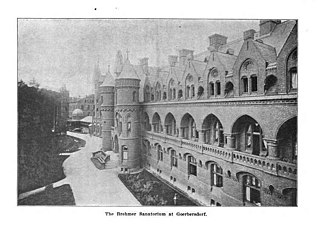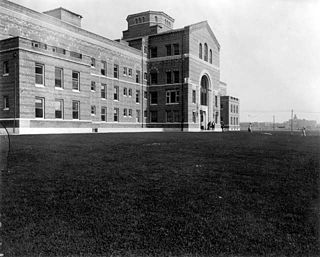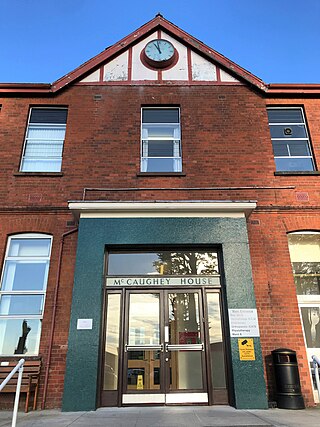Related Research Articles

A sanatorium, also sanitarium or sanitorium, are antiquated names for specialised hospitals, for the treatment of specific diseases, related ailments and convalescence. Sanatoriums are often in a healthy climate, usually in the countryside. The idea of healing was an important reason for the historical wave of establishments of sanatoriums, especially at the end of the 19th- and early 20th centuries. One sought, for instance, the healing of consumptives, especially tuberculosis or alcoholism, but also of more obscure addictions and longings of hysteria, masturbation, fatigue and emotional exhaustion. Facility operators were often charitable associations such as the Order of St. John and the newly founded social welfare insurance companies.
Sancta Maria College is a girls' Catholic voluntary secondary school in Ballyroan, Rathfarnham, County Dublin, Ireland. The school is governed by a board of management. There are approximately 525 students and 34 permanent teachers. It is run by the Sisters of Mercy.

National Jewish Health is a Denver, Colorado academic hospital/clinic doing research and treatment in respiratory, cardiac, immune and related disorders. It is an internationally respected medical center that draws people from many countries to receive care. Founded in 1899 to treat tuberculosis, it is non-sectarian but had funding from B'nai B'rith until the 1950s.

Muirdale Tuberculosis Sanatorium, also called Muirdale Tuberculosis Hospital, was built in 1914–15 by Milwaukee County, Wisconsin. It was located near the corner of Highway 100 and Watertown Plank Road in Wauwatosa and named after noted Wisconsin naturalist John Muir. Maximum capacity in 1923 was 350 patients, but in later years this figure rose to over 600, including a 100-bed Children's Cottage, or Preventorium, devoted to the treatment of young children.

Paimio Sanatorium is a former tuberculosis sanatorium in Paimio, Southwest Finland, designed by Finnish architect Alvar Aalto. Aalto received the design commission having won the architectural competition for the project held in 1929. The building was completed in 1933, and soon after received critical acclaim both in Finland and abroad. The building served exclusively as a tuberculosis sanatorium until the early 1960s, when it was converted into a general hospital. Today the building is owned by Turku University Hospital but is not functioning as a hospital; rather, the building has functioned as private rehabilitation center for children since 2014. The sanatorium has been nominated to become a UNESCO World Heritage Site.

Glen Lake Sanatorium, a tuberculosis treatment center serving Hennepin County in Minnesota, opened on January 4, 1916, with a capacity of 50 patients, and closed in 1976. In 1909, the Minnesota State Legislature had passed a bill authorizing the appointment of county sanatorium boards and appropriating money for the construction of county sanatoriums. Glen Lake Sanatorium was the fifth of fourteen county sanatoria that opened in Minnesota between 1912 and 1918. Glen Lake was the first U.S. tuberculosis sanatorium to be accredited by the American Medical Association.The sanatorium had its own post office, and the mailing address was Glen Lake Sanatorium, Oak Terrace, Minnesota, until the surrounding area was incorporated into the City of Minnetonka.

The Cayuga Nature Center (CNC) is an educational institution addressing nature and environmental issues. It is located on the west side of Cayuga Lake in Tompkins County, New York.
Kiekrz is part of the city of Poznań in western Poland, situated on the northwest edge of the city, adjoining Kierskie Lake. It has several holiday sites and sailing clubs, and a significant number of mainly detached houses. Kiekrz is one of the 42 neighbourhoods into which Poznań is divided for local government purposes.

Open air schools or schools of the woods were purpose-built educational institutions for children, that were designed to prevent and combat the widespread rise of tuberculosis that occurred in the period leading up to the Second World War. The schools were built to provide open-air therapy so that fresh air, good ventilation and exposure to the outside would improve the children's health. The schools were mostly built in areas away from city centers, sometimes in rural locations, to provide a space free from pollution and overcrowding. The creation and design of the schools paralleled that of the tuberculosis sanatoriums, in that hygiene and exposure to fresh air were paramount.

Cranberry Specialty Hospital was a tuberculosis sanatorium and later a chronic care facility in Hanson, Massachusetts operated by Plymouth County, Massachusetts, which was operational from 1919 until 1992.
Pine Bluff State Hospital was a tuberculosis sanatorium and isolation hospital in Salisbury, Maryland, in the United States. The hospital was built by The Pine Bluff Sanatorium Company. The hospital grounds contain three parcels, the first is 0.46 acres (0.19 ha), the second is 1.534 acres (0.621 ha), and the third 8.35 acres (3.38 ha).

The Indian hospitals were racially segregated hospitals, originally serving as tuberculosis sanatoria but later operating as general hospitals for indigenous peoples in Canada which operated during the 20th century. The hospitals were originally used to isolate Indigenous tuberculosis patients from the general population because of a fear among health officials that "Indian TB" posed a danger to the non-indigenous population. Many of these hospitals were located on Indian reserves, and might also be called reserve hospitals, while others were in nearby cities.
The town of Colorado Springs, Colorado, played an important role in the history of tuberculosis in the era before antituberculosis drugs and vaccines. Tuberculosis management before this era was difficult and often of limited effect. In the 19th century, a movement for tuberculosis treatment in hospital-like facilities called sanatoriums became prominent, especially in Europe and North America. Thus people sought tuberculosis treatment in Colorado Springs because of its dry climate and fresh mountain air. Some people stayed in boarding houses, while others sought the hospital-like facilities of sanatoriums. In the 1880s and 1890s, it is estimated that one-third of the people living in Colorado Springs had tuberculosis. The number of sanatoriums and hospitals increased into the twentieth century. During World War II, medicines were developed that successfully treated tuberculosis and by the late 1940s specialized tuberculosis treatment facilities were no longer needed.

White Cross Orphanage is a child caring agency in San Juan, Philippines that provides temporary shelter for children, who are 0–6 years old. Accredited by the Department of Social Welfare and Development (DSWD), it gives refuge to children of unwed mothers, indigent families, tuberculosis patients, mentally or physically-incapacitated parents, prisoners, or victims of incest or rape. These children are provided with medical assistance, educational care, and financial support to help them in their early years.

July Hargadine Thomson Collins was the founder and manager of the Night and Day Camp, a St. Louis city camping for the cure of tuberculosis targeting the poor women population of the city.

Whiteabbey Hospital is a hospital located close to the village of Whiteabbey, within the town of Newtownabbey, Northern Ireland. The hospital first opened in 1907 as The Abbey Sanitorium, centred around a country house known as 'The Abbey'. The house has stood on the site from 1850, and was once the residence of prominent architect Charles Lanyon. The hospital was extended and several buildings added throughout the early 20th century, and it was renamed Whiteabbey Hospital in 1947. The hospital is managed by the Northern Health and Social Care Trust. Many healthcare services have been withdrawn from the hospital, most recently with the closure of the Minor Injuries Unit in 2014.

Blue Ridge Sanatorium was a sanatorium for the treatment of tuberculosis located outside of Charlottesville, Virginia, United States.
The House of the Good Samaritan was a charitable, Boston hospital founded by Anne Smith Robbins in 1860. It accepted its first patients in 1861 and was established to care for destitute, chronically ill women and children. The hospital became affiliated in 1946 with Boston Children's Hospital. It was legally incorporated into Boston Children's Hospital in March 1967.

Tuberculosis Preventorium for Children in Lakewood Township, New Jersey was the first preventorium in the United States. It opened in July 1909, as an expression of Nathan Straus' desire to prevent the spread of tuberculosis among children. The children were selected mainly by the Association of Tuberculosis Clinics and were passed upon by the Department of Health of New York City. There were 32 of these clinics, to the nearest of which the parents applied. No discrimination was made as to race or creed, and there was no charge for transportation or board.
The Association of Tuberculosis Clinics was an early 20th-century organization of tuberculosis clinics based in New York City, New York. It was formed in 1907 with eight clinics in Manhattan and The Bronx, and was considered to be a forward movement of great importance in the tuberculosis campaign in New York City. Aside from the general object of combating tuberculosis and alleviating the condition of tuberculosis persons, the association aimed to prevent patients drifting from one clinic to another.
References
- ↑ "The Garrett Building: An Architectural Record of the Children's Preventorium Movement". 4 February 2012. Archived from the original on 2012-02-04.